Ian Gibbins
The Best Australian Science Writing 2016 edited by Jo Chandler
Gardens of Fire: An Investigative Memoir by Robert Kenny
Survival of the Beautiful: Art, science, and evolution by David Rothenberg
The Master and His Emissary: The Divided Brain and the Making of the Western World by Iain McGilchrist
How We Live and Why We Die: The secret lives of cells by Lewis Wolpert
On 17 July 1990, President George Bush Snr declared the 1990s as the ‘Decade of the Brain’, with the primary aim ‘to enhance public awareness of the benefits to be derived from brain research’. These benefits included better understanding of conditions such as Alzheimer’s disease, stroke and psychiatric disorders. In addition, remarkable advances occurred in functional brain imaging. This still-evolving technology reveals which parts of the brain are active while people carry out tasks of varying complexity, ranging from the manipulation of objects or the processing of sensory information, through to the analysis of problem solving, the voluntary control of emotional responses, or the reconstruction of imaginary events. Faced with a wealth of new experimental data, disciplines such as linguistics and philosophy can no longer develop theoretical models that treat the brain as a black box within which structure and function do not matter.
... (read more)Earth Under Fire: How Global Warming is Changing the World by Gary Braasch
1 preface
I could, if you prefer, create a list
like a birdwatcher, concealed
in a reedy hide, with binoculars,
field guide and record book, a mnemonic
of migration lines, our lines of sight,
a cladogram of our evolving past.








